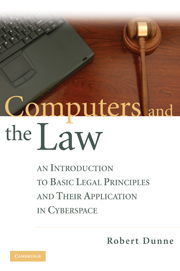Book contents
- Frontmatter
- Contents
- PREFACE
- ACKNOWLEDGMENTS
- 1 THE COMMON LAW AND STATUTORY LAW
- 2 CONTRACTS
- 3 TORTS INTRODUCTION
- 4 DEFAMATION
- 5 THIRD PARTY LIABILITY
- 6 COPYRIGHTS
- 7 TRADE SECRETS
- 8 TRADEMARKS
- 9 THE RIGHT OF PRIVACY
- 10 E-MAIL
- 11 THE RIGHT OF PUBLICITY
- 12 CONSTITUTIONAL LAW
- 13 PORNOGRAPHY AND OBSCENITY
- 14 ADVERTISING AND SPAM
- 15 JURISDICTION
- AFTERWORD
- INDEX
8 - TRADEMARKS
Published online by Cambridge University Press: 05 June 2012
- Frontmatter
- Contents
- PREFACE
- ACKNOWLEDGMENTS
- 1 THE COMMON LAW AND STATUTORY LAW
- 2 CONTRACTS
- 3 TORTS INTRODUCTION
- 4 DEFAMATION
- 5 THIRD PARTY LIABILITY
- 6 COPYRIGHTS
- 7 TRADE SECRETS
- 8 TRADEMARKS
- 9 THE RIGHT OF PRIVACY
- 10 E-MAIL
- 11 THE RIGHT OF PUBLICITY
- 12 CONSTITUTIONAL LAW
- 13 PORNOGRAPHY AND OBSCENITY
- 14 ADVERTISING AND SPAM
- 15 JURISDICTION
- AFTERWORD
- INDEX
Summary
Introduction
Products have trademarks. Services have service marks. The two will generally be referred to in this chapter generically as “trademarks,” but it is important to be aware of the distinction.
Trademarks can be almost anything, including:
Words or phrases
Pictures and symbols (like the Nike “swoosh”)
Numerals and letters (MCI)
Abbreviations and nicknames (Coke)
Colors (Owens Corning has a trademark on the pink color of its fiberglass insulation)
Sounds and music
Domain names
Smells (as is true of a particular scented yarn)
Buildings themselves (the Photomat “huts” for example)
Trademarks are easy to acquire. Simply select a mark and then use it in commerce. Ownership does not begin until the mark is used in commerce. However, application for a registration with the Patent and Trademark Office (PTO) can be made (and protection can begin) under an “Intent to Use” application for six-month intervals up to a maximum of thirty-six months. At some point during that time, a “Statement of Use” must be filed with the PTO, establishing that the mark has actually been used in commerce.
“Use in commerce” begins at the time the public first has a chance to associate the goods with the mark. Usually, this is when the goods are shipped or the services are first performed. Use in interstate commerce is required for federal, as opposed to state, registration, but this is easily established. Simply having customers from out of state is sufficient, and when the commerce is on the Net that is almost always the case.
- Type
- Chapter
- Information
- Computers and the LawAn Introduction to Basic Legal Principles and Their Application in Cyberspace, pp. 171 - 193Publisher: Cambridge University PressPrint publication year: 2009



